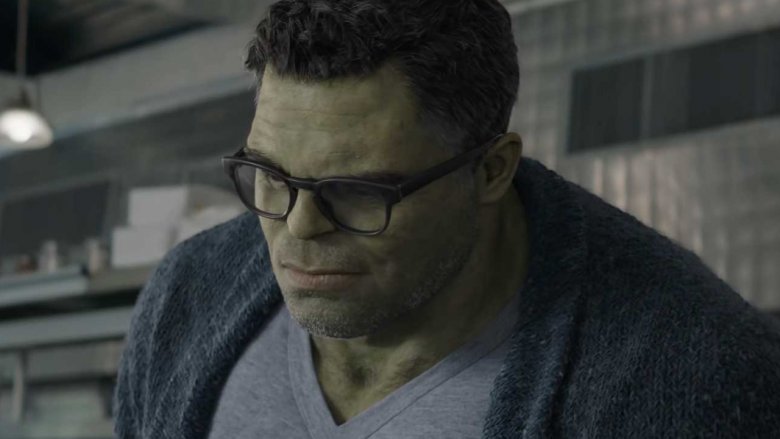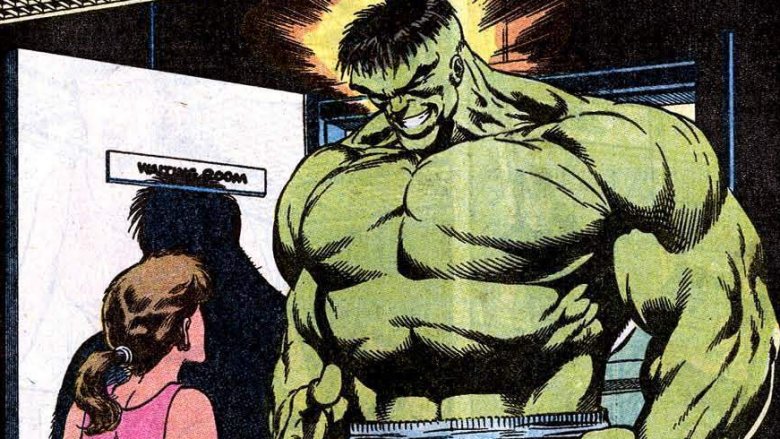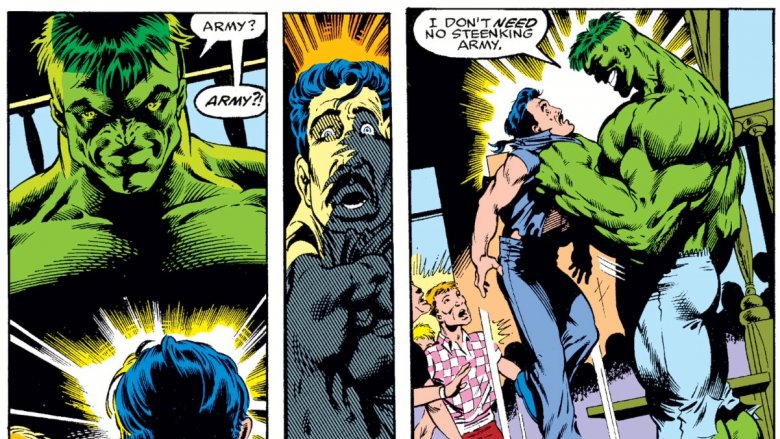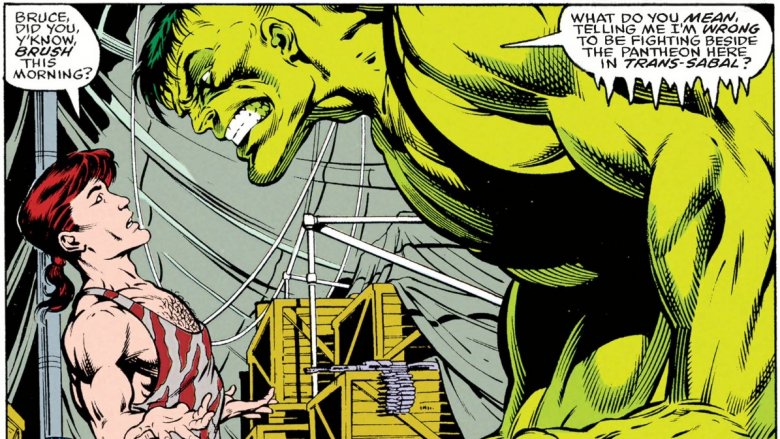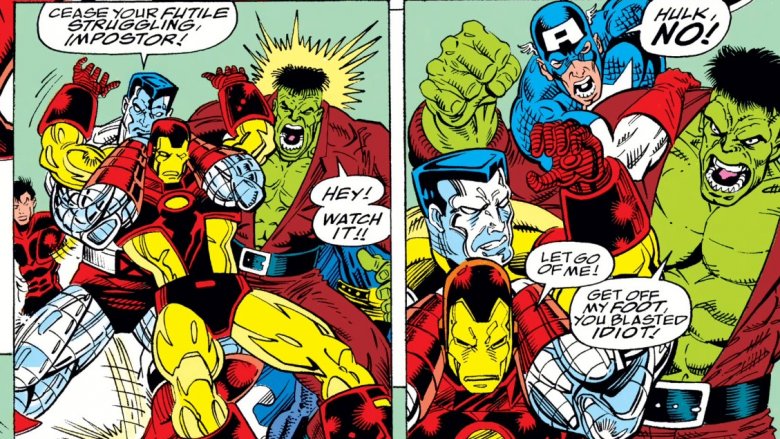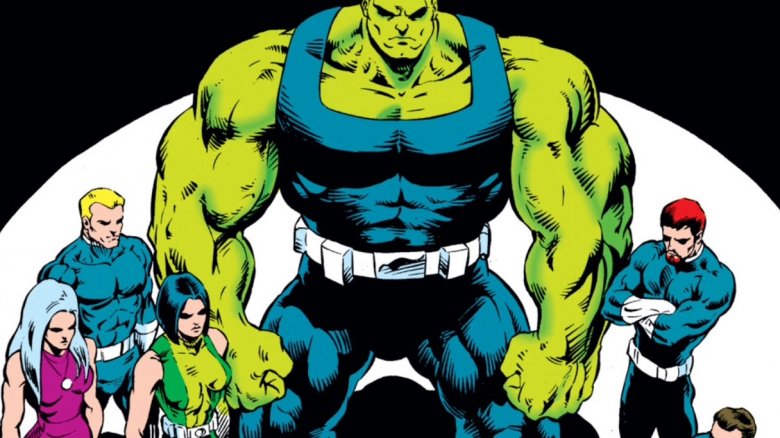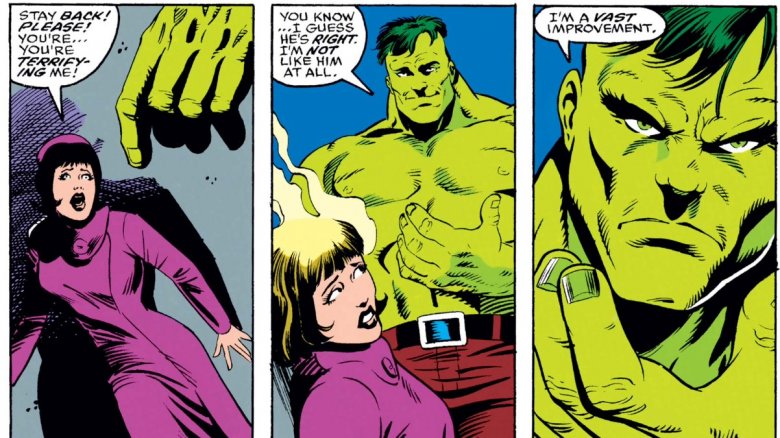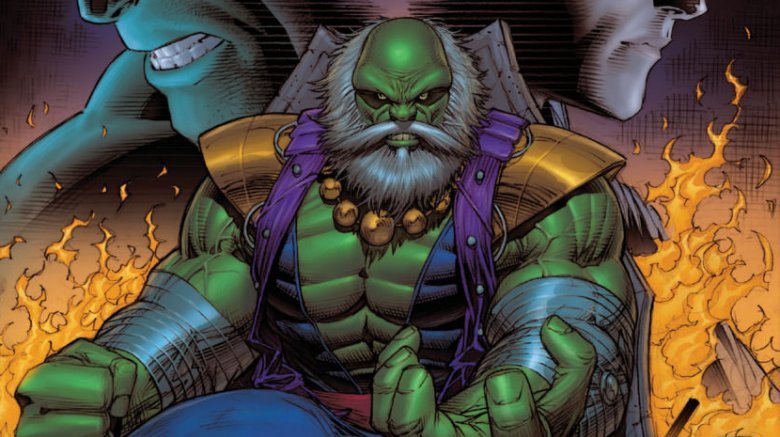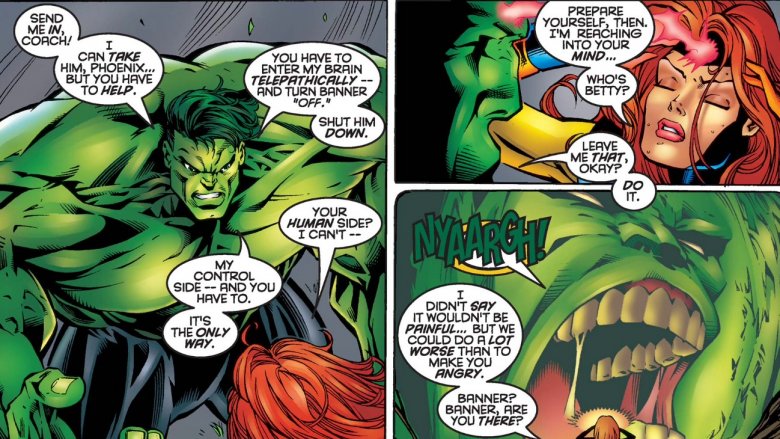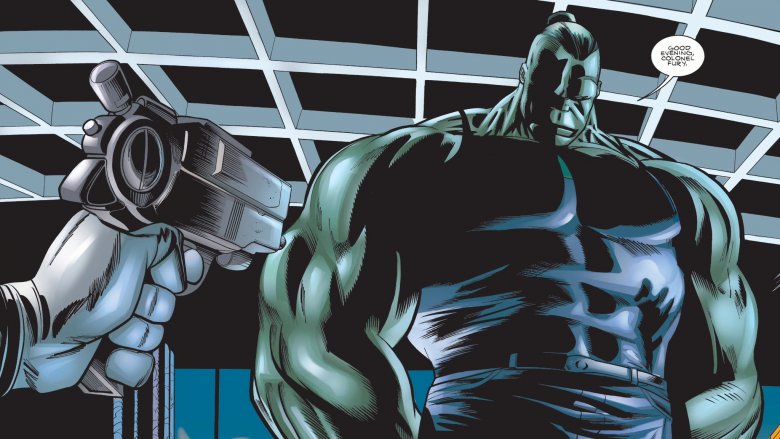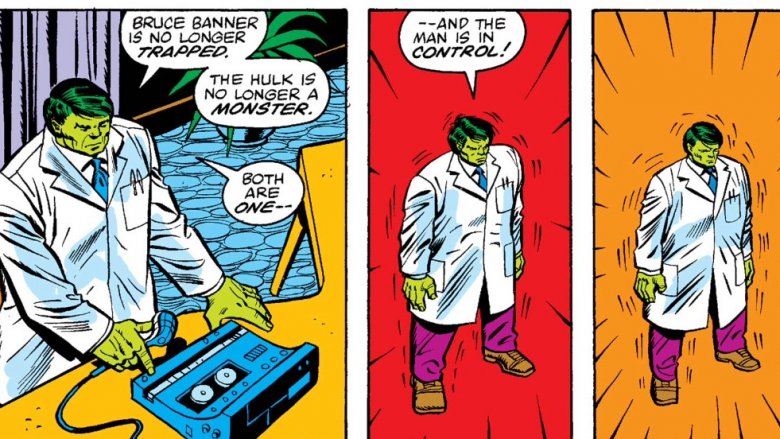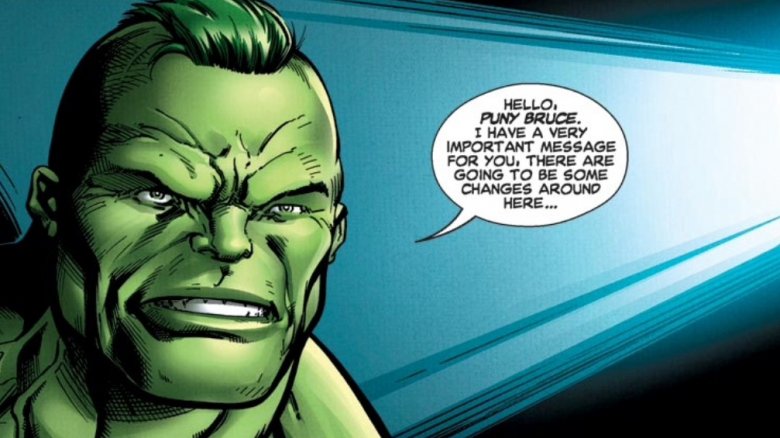The Untold Truth Of Professor Hulk
With Avengers: Endgame, audiences met a version of the Hulk referred to as "Professor Hulk." After some of the surviving Avengers are initially rebuffed when they ask Tony Stark (Robert Downey Jr.) to help them achieve time travel, they turn to Bruce Banner (Mark Ruffalo), who's very different from when we last saw him. The Avengers meet Bruce in a diner where they learn he's big and green all the time now, but with Bruce Banner's mind in control.
While the Hulk we meet in Endgame is closer to the Professor Hulk than anything seen previously in the MCU, the character in the comics is a much more complex animal. The Endgame version seems to basically be Hulk's body plus Banner's brain, but describing the Professor Hulk of the source material that way would be an oversimplification.
Originally referred to as the Merged Hulk, the Professor first appeared in 1991. Like the version we meet in Endgame, he possesses Banner's intelligence and remains big and green all the time, but he's far from the calm, good-natured, gentle giant we see in the film. The Professor Hulk is arrogant, emotionally unstable, and just as violent as his less educated predecessors. He harbors grudges against just about every other Marvel hero, and is eventually shown to have all the makings of a tyrant. If you're interested in how the character was originally portrayed, read on for the untold truth of Professor Hulk.
The merging
The Professor is born in 1991's Incredible Hulk #377 with the help of longtime Hulk frenemy Leonard Samson and an old school Marvel villain named the Ringmaster.
For the five years leading up to this storyline — since 1986's Incredible Hulk #324 — Bruce Banner has been a bit like a werewolf. At night he changes into a gray, thuggish, but smarter and more cunning version of the Hulk often referred to as "Joe Fixit." At dawn, Banner returns. In 1990's Incredible Hulk #372, the old-school savage green Hulk emerges with no immediate explanation, and shortly afterward in Banner's mind, a battle commences between the warring personalities of Banner, Fixit, and the savage Hulk. Leonard Samson — a gamma-powered hero who is also a famous psychiatrist — tries to end this conflict through hypnosis, digging up Banner's repressed memories of abuse.
With the Ringmaster using his hypnosis-inducing hat to help the process, Samson guides Banner and the other personalities through memories of Banner being beaten by his father Brian and eventually witnessing his mother's brutal death at his father's hands. On this psychic plane, we learn Banner created both versions of the Hulk to protect himself from trauma. With all three personalities finally facing their past, they are shown merging together. The comic book ends in the physical world, where Bruce's wife Betty is confronted by a green-skinned Hulk who smiles at her devilishly and says, "Honey... I'm home." This is the first appearance of Professor Hulk.
More than just brains and brawn
Early on, Professor Hulk proves himself to be more than just Hulk's body plus Banner's brain. If that's all there was to the character, he would act as we see in Endgame — smiling for selfies with kids, giving up his extra taco to a teammate, and all around being the same Bruce Banner we've gotten to know, just in a huge green body.
But that isn't the Professor Hulk of the comics. The Professor is the result of Samson's merging of three distinct personalities — Bruce Banner, the gray Hulk, and the green savage Hulk. He doesn't just have the brains of Banner and the power of the green Hulk; he has the confidence, sense of entitlement, and at times the sadism of the gray Hulk. Shortly after the merging, the Professor — against the psychiatrist's wishes — leaves Samson's office and heads to a nearby bar to show off his new status quo and have a good time. The Professor unquestioningly proclaims Samson will be paying for everything without asking beforehand, and when a group of rowdy locals try to bully Banner and company out of their table, Hulk lifts the leader of the locals off the floor and gives him a threatening grin that would make Jack Nicholson wet himself.
He was an emotional time bomb
Merging his personality with that of the savage Hulk and the gray Hulk didn't do much to help Banner's emotional stability. In many ways he was more unstable than ever.
A perfect example comes up in 1992's Incredible Hulk #391. The Hulk is in the fictional Middle East nation of Trans-Sabal, helping a group called the Pantheon overthrow the country's tyrannical leader. At first, Hulk's best bud Rick Jones is fully on board. While examining smashed enemy equipment, Jones learns Trans-Sabal's leader is receiving support from S.H.I.E.L.D., making him question if the Pantheon is fighting on the right side. When Jones confronts the Hulk in his tent with this, the Professor is enraged. He ends the conversation by smashing a table with the S.H.I.E.L.D. debris and stomping out of the tent. Jones waits a few seconds and follows his old friend out of the tent, only to find the Professor calmly leaning against some boxes with a much more considered counterpoint ready to present to Jones, acting as if the tantrum in the tent never happened.
The savage Hulk was always smashing things and would get angry at absolutely anything, but you could pretty much guess if he was around, he was angry. The savage Hulk, while savage, was at least consistent. Professor Hulk was more unpredictable. You didn't know what would set him off, what would get him screaming, or what would get him swinging.
He did not play well with others
Avengers: Endgame not only shows Professor Hulk to be much more of a team player than the less intelligent version of the "Other Guy," he's arguably one of the nicest people on the team. He stays calm when Thor (Chris Hemsworth) provokes him in New Asgard and he's friendly to Ant-Man while the Guardians refugees insult him.
In the comics, when it's time for all the Marvel heroes to unite, the Professor Hulk is no shiny, happy team player. In 1991's Infinity Gauntlet, the Professor almost refuses to help the rest of Marvel's heroes because of his Avengers founders' status being revoked years before. In the sequel Infinity War, while at a gathering of superheroes whose numbers dwarf those of Infinity Gauntlet's, the Professor Hulk throws a punch that starts a huge battle royale... all because the mutant hero Colossus accidentally steps on his foot. He's just as rude, dismissive, and insulting to his colleagues a year later in Infinity Crusade.
The Professor has just as many "misunderstandings" that turn physical with other superheroes as his more savage counterpart. Between his emergence in 1991 and his disappearance in 1996's Onslaught, the Professor Hulk clashes with Doc Samson, Iron Man, X-Factor, Luke Cage, Drax the Destroyer, Venom, the Punisher, Captain America, She-Hulk, Spider-Man, the assembled Avengers, and more — including three different clashes with Thor. He might have a higher S.A.T. score than the other Hulks, but he likes to fight just as much.
The Pantheon
Shortly after he emerges, Professor Hulk is recruited into a paramilitary organization of mythic-themed superheroes called the Pantheon. Their initial recruiting technique is to kidnap him in 1991's Incredible Hulk #381. Predictably, he doesn't remain their prisoner for long, but regardless, their mysterious leader Agamemnon gets the Professor to join them by convincing him it's the perfect opportunity for him to redeem himself for the damage caused by less intelligent versions of the Hulk. The Professor eventually becomes the Pantheon's leader, but everything falls apart in 1994's Incredible Hulk #424 when the Pantheon's headquarters is destroyed and a number of its members are murdered.
Professor Hulk's time with the Pantheon is a double-edged sword. On one hand, while it lasts, the Hulk enjoys things he's desperately needed for a long time like friends, roots, and a sense of responsibility. On the other hand, the group's often clandestine goals bring out a dark side to the Professor. At times he seems less like a hero and more like a bully, ready to impose his will violently regardless of what anyone else thinks. Leading the Pantheon gives the Hulk a kind of power he's never had before — leadership. We eventually learn that putting the Hulk in a leadership role is a cataclysmically bad idea — for the Hulk's sake and that of the rest of the world.
A darker Hulk
Of the words you'd use to describe the classic monosyllabic "HULK SMASH" version of the Hulk,"arrogant" probably wouldn't be a top choice. But whether it's a trait associated with him or not, the Hulk has never been shy about his confidence in his superiority. Only slightly less well-known than "Hulk Smash" is his catchphrase "Hulk is the strongest one there is!" He regularly refers to people as "puny humans," implying not only that he's more powerful, but that rather than being human himself, he's something better.
Just as he has the gray Hulk's confidence, Professor Hulk also shares the savage Hulk's sense of superiority. In 1991's Incredible Hulk #383, the Professor complains about needing to climb down a building rather than jumping off of it because jumping would mean crushing people on the street below. Rather than accepting this as an unfortunate reality, the Professor calls the people "idiots" for getting in his way. While having a vision of himself meeting with past versions of Bruce Banner and Betty Ross in 1992's Incredible Hulk #399, the Professor admits he sees himself as a "vast improvement" from the Bruce Banner of the past.
With the savage Hulk's certainty he was better than everyone else, and with Banner's intellect to back up that towering sense of worth with more than just fists, the Professor Hulk began a transformation into one of the most dangerous characters in Marvel's history: The Maestro.
The Maestro
In the 1992 miniseries Incredible Hulk: Future Imperfect, Professor Hulk is brought to the future by allies of his friend Rick Jones. Upon arriving, the Hulk only knows that most of Earth is an irradiated wasteland and a powerful tyrant called the Maestro rules over what little is left — the city Dystopia. After a brief but violent encounter with the Maestro's forces in the Dystopia marketplace, the Professor is brought to the rebel headquarters, where he meets the aged Rick Jones who tells him the Maestro and Professor Hulk are the same person. The Professor learns that one day, made even stronger by the irradiated atmosphere and with no governments or superheroes left to challenge him, he will become the Maestro.
While the Maestro's appearances have been sparse since Future Imperfect, he's proved a popular villain who haunts Bruce Banner. The idea that the Hulk's power and ego could lead to the character becoming a tyrant and/or destroying on a more global scale has been a recurring theme ever since Future Imperfect. The Hulk became the ruler of Australia – one of the only successful holdouts against Magneto's reign – in the 2005 line-wide event House of M. He literally waged war on Earth in 2007's World War Hulk. More recently in 2019, in issues of Immortal Hulk and the miniseries Avengers: No Road Home, the current version of the Hulk has admitted that his ultimate goal is to destroy Earth.
Onslaught
In 1996's Onslaught: Marvel Universe #1, the Professor Hulk makes his last 20th century appearance. Joining the X-Men, Fantastic Four, and Avengers in their final battle against Onslaught, the Professor asks Jean Grey to psychically turn off Bruce Banner's personality to make room for the kind of savagery that will allow him to win. Grey does as he asks, and the plan works — the savage Hulk emerges and is able to pierce the villain's armor. The power backlash from the strike is so intense it physically separates Bruce Banner from the Hulk.
After Onslaught, Bruce Banner enters the "Heroes Reborn" universe along with the Avengers and Fantastic Four (who are presumed dead in Marvel's prime continuity). In the Heroes Reborn world, Banner's life is rebooted. Once again, he switches between himself and the savage Hulk, but this time the savage Hulk has long hair and is constantly buck naked. Meanwhile, on the prime Marvel Earth, the Hulk exists with his main personality carved out of him, leaving him with the feeling of an unidentifiable emptiness. He has the myopic rage and power of the savage Hulk, the cunning and sadism of the gray Hulk, but with Banner's persona missing. The fractured pieces of the Hulk are reunited a year later with Heroes Reborn: The Return, but Professor Hulk wouldn't be seen again until 2000.
Birth of 'The Professor'
After a series reboot and a bunch of creative team changes, the Professor is seen again in 2000's Incredible Hulk #12. Banner's trauma and the notion that the character suffers from Disassociative Identity Disorder is once again expanded upon, and the Professor Hulk has a difficult revelation waiting for him. The Professor, we learn, is not the merging of Banner's fractured personalities, but just one more of Banner's splintered creations. At first, the Professor refuses to accept the truth, but eventually acquiesces to the logic of it. This, in fact, is the first time this version of the Hulk is referred to as "The Professor."
During this period, the dominant Hulk cycles between the Professor, the savage Hulk, and the gray Hulk. When it comes to Banner learning new things about himself, the truth of the Professor Hulk's nature is just the tip of the iceberg. Banner returns to psychic landscapes where we see dozens of separate personalities including a clown Hulk, a Hulk whose bottom half is that of a giant snake's, a Hulk in a tuxedo with a Fu-Manchu mustache, and so on. Most of these will never become dominant in the years to come. But there is one massive, orange-scaled creature chained in a cave who becomes known as the Devil Hulk. In 2019's Immortal Hulk #15, we learn the Devil Hulk is the one currently in the driver's seat.
The Banner Hulk
Over the course of almost six decades, the Hulk has experienced a lot of personality changes. For those not intimately familiar with the character's stories, it can be more than a little confusing. The emergence of Professor Hulk is not the only time the Hulk enjoyed Banner's genius intelligence; because of this, the Professor is often confused with other versions of the Hulk. Perhaps most commonly, he's confused with the Banner Hulk.
In 1982's Incredible Hulk #272, after increased exposure to gamma radiation, Bruce Banner wins control over his transformations into and out of the Hulk's body. Once the world at large learns of the development and the Hulk helps repel what everyone believes is an alien invasion (but is actually staged by the Hulk's nemesis the Leader), the Hulk is pardoned for past crimes, enjoys a massive ceremony honoring his heroism in New York City including just about every Marvel hero you could think of, and eventually is invited to return to the Avengers (an invitation he politely declines).
Ironically, while the Banner Hulk was not the Professor Hulk, in a lot of ways he more closely resembles the Professor Hulk of Avengers: Endgame. Like the movie version, the Banner Hulk truly is just the Hulk's brawn plus Banner's brain, with no contributions of personality from the gray or savage Hulks. And like Endgame's Professor Hulk, the Banner Hulk comes about through lab science rather than any supervillain-aided therapy sessions.
Doc Green
A more recent Hulk incarnation who is often confused with the Professor is Doc Green.
After Bruce Banner is shot in the head by a mystery assailant in 2014's Indestructible Hulk #20, his old friend Tony Stark saves his life by using the comic book version of Extremis (which appears in the MCU in Iron Man 3). The Extremis does more than save Banner's life, however; it creates a new personality. Doc Green is a super-intelligent version of the Hulk who believes the world is threatened by a growing number of gamma-irradiated individuals. He develops a cure and uses it on most of Marvel's gamma-powered heroes and villains, whether they like it or not. The involuntarily cured include Betty Banner, a.k.a. Red She-Hulk; Rick Jones, a.k.a. A-Bomb; General Ross, who was the first Red Hulk; and even Banner's own son Skaar.
You couldn't be blamed for confusing the Professor with Doc Green. They have a lot in common. They both enjoy genius intellect and the will to do what they feel has to be done regardless of what others want. In fact, like the Professor, Doc Green is haunted by visions of the Maestro. He suffers nightmares in which, as the Maestro, he slaughters the rest of Marvel's heroes. The most blatant difference between him and the Professor is Doc Green's antagonistic attitude towards Banner. He often records insulting messages to his smaller self, calling him names like "Puny Bruce."
